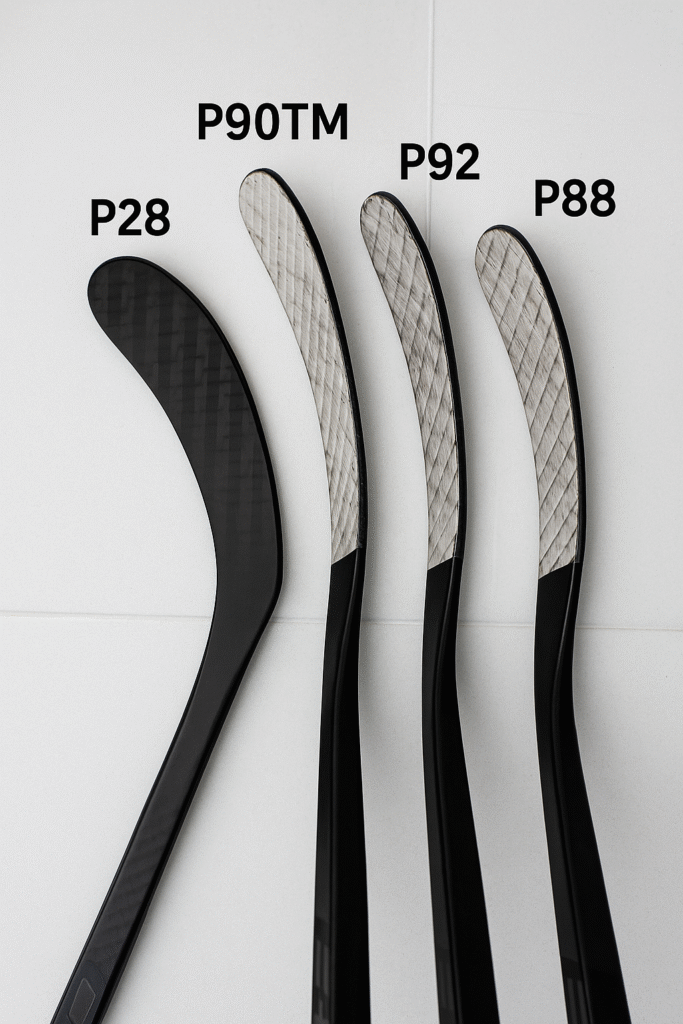If you’ve ever stood in front of a stick rack unsure whether to grab a P92 or a P28, you’re not alone. Blade curves can totally change how your shot, pass, and control feels, and it’s one of the most misunderstood parts of picking a stick in ball hockey.
Over the years, I’ve tried almost every curve in the game — Easton, Bauer, CCM, Warrior — even those weird custom pro patterns you only see once in a blue moon. But if I’m being honest? My all-time favourite was the P88.
Let’s break down why, what replaced it, and how to choose between today’s most popular curves: P92 vs P28.
The P88: The Forgiving Workhorse (RIP)
The P88 was that curve you could rely on for anything. Not too deep. Slightly open. Great for shooting, passing, puck/ball control, all without punishing you for mishits.
It didn’t force your hands to be perfect. It didn’t exaggerate toe drag or flicks. It was just… easy. And that’s why I loved it.
Unfortunately, most brands don’t make it anymore. Bauer and CCM have phased it out. Warrior still has a version (W88), but it’s slowly disappearing from shelves.
The P92: The New Default (aka “Sakic”)
The P92 took over as the go-to for most players. It’s got a mid-toe curve with a slightly open face, perfect for snapshots, saucer passes, and lifting the puck/ball in tight.
Pros:
- Great for quick-release shots
- Easy to elevate the puck/ball (especially close to the net)
- Works well for saucer passes and floaters
Cons:
- Less control on backhands
- Can cause puck/ball to sail high if you’re not careful
- Slightly harder to cradle flat passes or rebounds
If you’re a shooter-first kind of player, especially on your forehand, P92 gives you that extra lift without too much exaggeration.
The P28: The Toe Curve Weapon (aka “McDavid”)
The P28 is all about toe control. It’s a very aggressive toe curve with an open face, designed for quick toe drags, top-shelf flicks, and handling the puck/ball in tight spaces.
Pros:
- Great for toe drags and toe flicks
- Quick release when shooting from the toe
- Snappy feel for skilled puck/ball handlers
Cons:
- Terrible for backhands
- Harder to corral bouncing puck/balls
- Takes time to adjust if you’re used to a mid curve
If you love dangling, walking off the wall, or pulling the puck/ball in and snapping it, the P28 is built for that modern, flashy style. But it’s not the easiest curve to just pick up and play with.
My Verdict (As a Ball Hockey Player)
If you grew up on the P88, you’ll probably miss how neutral and forgiving it was. It let you play your game without overcompensating for your stick.
Now that the mainstream options are P92 and P28, here’s the TL;DR:
- P92 = safer choice, good all-around shooter’s curve
- P28 = more advanced, rewards toe shooters and skilled handlers
- P88 (if you can still find it) = balanced, reliable, backhand-friendly
For most ball hockey players, the P92 is the smarter pickup — unless you’re confident in your touch and want to lean into a toe-heavy style with the P28.
Final Word
Your curve should match how you play. Don’t just follow trends.
If you’re just getting into the game, start with the P92. If you want to experiment, try a P28 for a few runs and see what feels natural. And if you ever spot a P88 on clearance? Grab it. Trust me.
I am currently using P28 as I find I can drag more in tight spaces between defenders.

